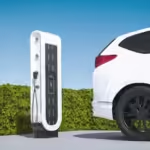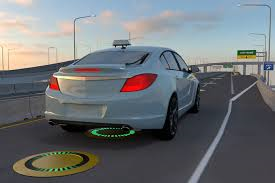An EV charging road, also known as an electric or wireless charging road, is a type of infrastructure designed to charge electric vehicles (EVs) while they are in motion. These roads utilize inductive charging technology to wirelessly transfer electrical energy from the road surface to the vehicle’s battery pack, eliminating the need for traditional plug-in charging stations. EV charging roads offer the potential for continuous charging, enabling EVs to travel longer distances without the need for frequent stops to recharge.
Components of an EV Charging Road:
1. Inductive Charging Coils: Inductive charging coils are embedded within the road surface at regular intervals. These coils generate an alternating magnetic field, which induces an electrical current in corresponding coils installed in EVs passing over the road.
2. Vehicle Receiver Coil: Each participating EV is equipped with a receiver coil installed underneath the vehicle. When the vehicle passes over the inductive charging coils in the road, the receiver coil captures the electromagnetic energy and converts it into electrical energy to charge the vehicle’s battery pack.
3. Control and Monitoring System: A control and monitoring system manages the operation of the EV charging road, including power distribution, billing, and communication with participating vehicles. This system ensures the efficient and safe operation of the charging infrastructure.
READ ALSO: Impact of Using the Wrong Engine Oil on Various Types of Engines 1

Types of EV Charging Roads:
1. Dynamic Wireless Charging Roads: Dynamic wireless charging roads allow EVs to charge while in motion, providing continuous charging along designated roadways. These roads are typically installed on highways or major transportation corridors to enable long-distance travel without the need for extended stops to recharge.
2. Stationary Wireless Charging Roads: Stationary wireless charging roads provide charging infrastructure at fixed locations, such as intersections, parking lots, or rest areas. EVs can park or stop over designated charging zones to replenish their battery packs wirelessly.
Locations and Implementation:
EV charging roads are still in the experimental and pilot phases in various countries around the world. Several projects and initiatives have been launched to test and develop this innovative technology. Some notable examples include:
1. Sweden: Sweden has been a pioneer in EV charging road technology, with the development of the eRoadArlanda project near Stockholm. This project features a two-kilometer stretch of electrified road equipped with conductive rails embedded in the surface, allowing electric trucks to charge while driving.
2. South Korea: South Korea has invested in the development of wireless charging technology for electric buses. In the city of Gumi, a wireless charging road has been installed on a public bus route, allowing electric buses to charge wirelessly at designated stops.
3. Israel: Israel is exploring the feasibility of wireless charging technology for electric buses through the ElectReon project. This project involves the installation of wireless charging infrastructure along a public bus route in Tel Aviv, enabling electric buses to charge while in operation.
4. China: China has invested in the development of dynamic wireless charging technology for electric vehicles. Several pilot projects have been launched in cities like Beijing and Shanghai to test dynamic wireless charging roads on public transportation routes.
READ ALSO: HISTORY OF ELECTRIC VEHICLES { E.Vs }
Reliability and Charging Speed:
The reliability and charging speed of EV charging roads depend on various factors, including the design of the infrastructure, the efficiency of the charging system, and the compatibility with participating vehicles. While EV charging roads offer the potential for continuous charging and seamless integration into existing road networks, there are several challenges to overcome:
1. Efficiency: Inductive charging technology may not be as efficient as traditional plug-in charging methods, resulting in slower charging speeds and higher energy losses during transmission.
2. Compatibility: Participating vehicles must be equipped with compatible receiver coils and charging systems to utilize EV charging roads effectively. Retrofitting existing vehicles or integrating charging capabilities into new vehicles may require additional costs and modifications.
3. Maintenance: EV charging roads require regular maintenance to ensure the proper functioning of the infrastructure, including inspection of charging coils, repair of damaged road surfaces, and calibration of control systems.
4. Cost: The installation and operation of EV charging roads involve significant upfront costs, including the construction of specialized infrastructure, deployment of control and monitoring systems, and integration with existing transportation networks.
Advantages of EV Charging Roads:
1. Continuous Charging: EV charging roads enable continuous charging while vehicles are in motion, eliminating the need for frequent stops to recharge and extending the driving range of electric vehicles.
2. Convenience: Wireless charging infrastructure provides a convenient and user-friendly experience for EV drivers, reducing the hassle of finding and using traditional plug-in charging stations.
3. Reduced Environmental Impact: EV charging roads contribute to the reduction of greenhouse gas emissions and air pollution by promoting the adoption of electric vehicles and displacing fossil fuel-powered vehicles.
4. Integration with Existing Infrastructure: EV charging roads can be integrated into existing road networks and transportation infrastructure, leveraging existing right-of-ways and minimizing disruption to traffic flow.

READ ALSO: AeroMobil: Flying Cars,The Future 1 of Mobility Breaking
Disadvantages of EV Charging Roads:
1. High Initial Costs: The installation and operation of EV charging roads involve significant upfront costs, including infrastructure construction, equipment deployment, and maintenance expenses.
2. Charging Efficiency: Inductive charging technology may be less efficient than traditional plug-in charging methods, resulting in slower charging speeds and higher energy losses during transmission.
3. Compatibility Issues: Participating vehicles must be equipped with compatible receiver coils and charging systems to utilize EV charging roads effectively, requiring retrofitting or modifications for existing vehicles.
4. Limited Availability: EV charging roads are still in the experimental and pilot phases, with limited availability and coverage in specific locations. Expansion and deployment on a larger scale will require further research, development, and investment.
EV charging roads represent a promising innovation in the field of electric vehicle infrastructure, offering the potential for continuous charging and seamless integration into existing transportation networks. However, significant challenges remain to be addressed, including cost, efficiency, compatibility, and availability, before EV charging roads can become widely adopted and commercially viable on a global scale. Continued research, development, and collaboration among stakeholders will be essential to overcome these challenges and unlock the full potential of EV charging road technology.












